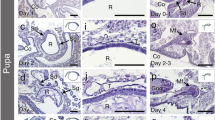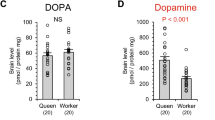Summary
The endocrine system of female honey bee larvae has been studied through postembryonic development with histological and autoradiographic techniques. During larval development, brain and retrocerebral complex proceed from immature cells to an active endocrine system. Caste-specific retardation occurs in the worker during this process. In the developing queen, the differentiation of the neurosecretory cells (NSC) and the outgrowth of their axons occurs from the second instar onward and is nearly completed in the fourth, whereas in the worker larva these processes are delayed by more than one instar. In the queen, RNA synthesis starts in the NSC at the end of the third instar and in the worker at the fifth instar. Stainable neurosecretory material is present only in fifth instar queen larvae. The queen's corpora cardiaca become active at the end of the fourth, those of the worker in the fifth instar. In the corpora allata (CA), nuclei undergo several phases of endomitosis. These phases of polyploidization end at the beginning (queen) or at the end (worker) of the fifth instar respectively. CA volume in the queen is twice that of a worker at its height at the end of larval development. These data demonstrate a caste-specific maturation of the endocrine organs which results in differences in hormone titres.
Similar content being viewed by others
References
Adam H, Czihak G (1964) Arbeitsmethoden der makroskopischen und mikroskopischen Anatomie. Gustav Fischer, Stuttgart, pp 316–319
Dörmer P (1973) Quantitative autoradiography at the cellular level. In: Neuhoff V (ed) Molecular biology, biochemistry and biophysics 14, Micromethods in Molecular Biology. Springer, Berlin Heidelberg New York, pp 347–393
Dogra GS, Ulrich GM, Rembold H (1977) A comparative study of the endocrine system of the honey bee larvae under normal and experimental conditions. Z Naturforsch 32c:637–642
Fyg W (1959) Normal and abnormal development in the honey bee. Bee World 40:57–66
Hagenguth H, Rembold H (1978) Kastenspezifische Modulation des Ecdysontiters bei der Honigbiene. Mitt dtsch Ges angew Ent 1:296–298
Jung-Hoffmann I (1966) Die Determination von Königin und Arbeiterin der Honigbiene. Z Bienenforsch 8:296–321
Novak VJA (1975) Insect hormones. 2nd Engl ed. Chapman and Hall, London
Rembold H, Hagenguth H (1981) Modulation of hormone pools during postembryonic development of the female honey bee castes. In: Sehnal F (ed) Regulation of insect development and behaviour. Wroclaw Techn. Univ. Press, Wroclaw, pp 427–440
Rembold H, Lackner B (1981) Rearing of the honey bee larvae in vitro: effect of yeast extract on queen differentiation. J Apicult Res 20:165–171
Rembold H, Kremer JP, Ulrich GM (1980) Characterization of postembryonic developmental stages of the female castes of the honey bee, Apis mellifera L. Apidologie 11:29–38
Rhein W v (1933) Über die Entstehung des weiblichen Dimorphismus im Bienenstaat. Arch Entwicklungsmech 129:601–665
Townsend GF, Shuel RW (1962) Some recent advances in apicultural research. Ann Rev Entomol 7:481–500
Truman JW, Taghert PH, Copenhaver PF, Tublitz NJ, Schwartz LM (1981) Eclosion hormone may control all ecdyses in insects. Nature 291:70–71
Weaver N (1966) Physiology of caste determination. Ann Rev Entomol 11:79–102
Weiss K (1971) Über Ausbildung und Leistung von Königinnen aus Eiern und jungen Arbeiterinnen. Apidologie 2:3–47
Zander E, Becker F (1925) Die Ausbildung des Geschlechts bei der Honigbiene II. Erlanger Jb Bienenk 3:163–223
Author information
Authors and Affiliations
Additional information
From a dissertation of G.M. Ulrich (1979), University of Cologne
Rights and permissions
About this article
Cite this article
Ulrich, G.M., Rembold, H. Caste-specific maturation of the endocrine system in the female honey bee larva. Cell Tissue Res. 230, 49–55 (1983). https://doi.org/10.1007/BF00216026
Accepted:
Issue Date:
DOI: https://doi.org/10.1007/BF00216026




